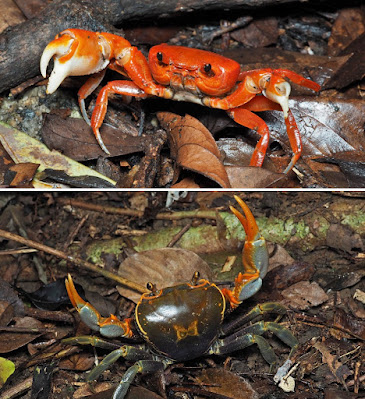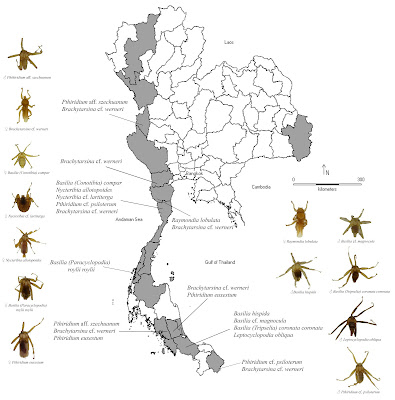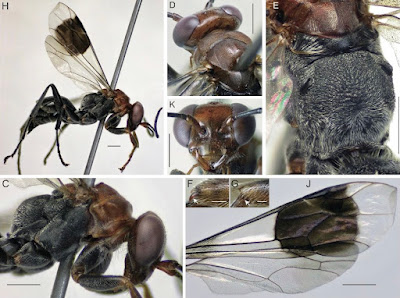[Most Recent Entries] [Calendar View]
Friday, August 27th, 2021
| Time | Event | ||||||
| 1:25a | [Crustacea • 2021] Nanhaipotamon incendium & N. aureomarginatum • Two New Freshwater Crab Species of the Genus Nanhaipotamon Bott, 1968 (Decapoda, Potamidae) from Huizhou, Guangdong Province, southern China
Abstract Two morphologically distinct new species of Nanhaipotamon Bott, 1968, are described from Huizhou, Guangdong Province, southern China. The smooth carapace and lack of flagellum on the third maxilliped exopod immediately separate N. incendium n. sp. from all other known Nanhaipotamon. It is also the first species of this genus to be recorded from a relatively high altitude of 700 m a.s.l. Nanhaipotamon aureomarginatum n. sp. is externally much more typical of species of its genus but can be distinguished from congeners by its unique male first gonopod. The two new species are more or less sympatric with a morphological disparate congener, which we tentatively assign as N. aff. aculatum Dai, 1997 and N. aff. hongkongense (Shen, 1940), respectively, but with different habitats. A genetic analysis using the mitochondrial cytochrome oxidase subunit I shows that while the two new species are sufficiently distinct from other known species of Nanhaipotamon, they have extraordinarily close relationships with their respective sympatric congeners, which calls for further investigation. The ecology of these two new species are also noted. Key words: cytochrome oxidase subunit I (COI), hillstream, new species, sympatric, systematics
Family Potamidae Ortmann, 1896 Subfamily Potamiscinae Bott, 1970 Genus Nanhaipotamon Bott, 1968 Type species. Potamon (Potamon) formosanum Parisi, 1916, by original designation; gender neuter. Nanhaipotamon incendium n. sp. Diagnosis. Carapace broader than long, regions indistinct (Fig. 1). Dorsal surface smooth, finely pitted, convex (Fig. 1). Anterolateral margins smooth, lined with numerous indistinct granules (Fig. 1). Posterolateral surfaces smooth (Fig. 1). Sub-orbital, sub-hepatic and pterygostomial regions clearly divided by sutures, with smooth and pitted surface (Fig. 2A). Maxilliped III exopod reaching to proximal one-fifth of merus, flagellum absent (Fig. 3A). G1 slender, reaching beyond pleonal locking tubercle almost up to suture between sternites IV/V in situ (Fig. 2D). G1 subterminal segment 2.6–2.7 × as long as terminal segment, tapering distally. G1 terminal segment relatively small, inverted foot-shaped; inner proximal margin strongly concave; inner distal margin almost straight to gently convex; apex acute, directed outward, orientation oblique to longitudinal axis of G1 (Figs. 3C–E, 7I, J). G2 subterminal segment 2.0–2.1 × as long as flagellum-like terminal segment (n = 3) (Fig. 3B). Etymology. The specific name “incendium” means fire in Latin, which describes the live colouration of the species. The name thus is to be conceived as a noun in the nominative singular standing in apposition to the generic name.
Nanhaipotamon aureomarginatum n. sp. Diagnosis. Carapace broader than long, regions indistinct (Fig. 4). Dorsal surface generally smooth, pitted, convex, slightly rugose on anterolateral regions in smaller specimens (Fig. 4). Anterolateral margins cristate with fused granules, bent inward posteriorly (Fig. 4). Posterolateral surfaces with low, oblique striae converging posteriorly; granules scattered among striae, some merged together (Fig. 4). Sub-orbital, pterygostomial regions covered with large round granules; sub-hepatic region with lines of fused smaller granules (Fig. 5A). Maxilliped III exopod reaching to proximal one-third of merus, with flagellum (Fig. 6A). G1 slender, reaching beyond suture between sternites IV/V in situ (Fig. 5D). G1 subterminal segment 2.1–2.2 × as long as terminal segment. G1 terminal segment large, duck head-shaped; mesial margin strongly convex; outer margin strongly concave; anterior margin almost straight, oblique to longitudinal axis of G1; apex pointing outwards (Figs. 6C–E, 7K, L). G2 subterminal segment 1.7–1.8 × as long as flagellum-like terminal segment (Fig. 6B). Etymology. The specific name “aureomarginatum” alludes to the new species’ golden-coloured anterolateral margins of the carapace. The name thus is to be conceived as an adjective in the nominative singular. Chao Huang, Si Ying and Hsi-Te Shih. 2021. Two New Freshwater Crab Species of the Genus Nanhaipotamon Bott, 1968 (Crustacea, Decapoda, Potamidae) from Huizhou, Guangdong Province, southern China. Zootaxa. 5026(2); 221-238. DOI: 10.11646/zootaxa.5026.2.4 | ||||||
| 1:38a | [Entomology • 2021] A Checklist of Bat Flies (Diptera: Nycteribiidae and Streblidae) from Thailand with Thirteen New Records for the Country
Abstract The Nycteribiidae and Streblidae are known as two families of obligate blood sucking ectoparasites of bats. Recent data on nycteribiid and streblid bat flies collected from 15 provinces in Thailand during 2018–2020 are hereby presented with data from previous studies. This study recorded 26 species belonging to nine genera of Nycteribiidae and Streblidae known to be associated with 44 host bats species. Thirteen species of which, 11 nycteribiids and two streblids, are herein recorded from Thailand for the first time. Altogether with previously reported records, this paper lists a total of 59 known bat flies, 43 nycteribiids and 16 streblids, with their 63 associated host bat species. Keywords: bats, bat flies, Chiroptera, checklist, Nycteribiidae, Streblidae Abdulloh Samoh, Vatanya Pantip and Pipat Soisook. 2021. A Checklist of Nycteribiid and Streblid Bat Flies (Diptera: Nycteribiidae and Streblidae) from Thailand with Thirteen New Records for the Country. Tropical Natural History. 21(2); 244-262 | ||||||
| 8:57a | [Entomology • 2021] Maurillus argenticapitis, Maurilloides nigrisoma & Evansiclavelia poecilopteryx • Systematics and Convergent Evolution in Three Australian Genera of Pepsinae Spider Wasps (Hymenoptera: Pompilidae)
Abstract We treat the Australian spider wasp ‘Ctenocerini’, revising the systematics of Maurillus Smith, adding a new species Maurillus argenticapitis Pitts & Shimizu sp. nov. and describing two new monobasic genera Maurilloides Pitts & Shimizu gen. nov. based on Maurilloides nigrisoma Pitts & Shimizu sp. nov. and Evansiclavelia Pitts, Rodriguez & Shimizu gen. nov. based on Evansiclavelia poecilopteryx Pitts, Rodriguez & Shimizu sp. nov. We further discuss the phylogenetic position of Maurillus and the convergent evolution of the modification in head and pronotal structures occurring in the above three genera, as well as in pompilids from other subfamilies, that parasitise trapdoor spiders. Keywords: Evansiclavelia, Maurilloides, Maurillus, parasitoid, taxonomy, trapdoor Maurillus argenticapitis Pitts & Shimizu sp. nov. Etymology: The species name is derived from the greater part of the head covered with silvery-white pubescence. Maurilloides Pitts & Shimizu gen. nov. Etymology: The generic name is derived from a morphological similarity to Maurillus. The name is considered masculine in gender. Maurilloides nigrisoma Pitts & Shimizu sp. nov. Etymology: The species name is derived from the wholly black body. Evansiclavelia Pitts, Rodriguez & Shimizu gen. nov. Etymology: The generic name is in honour of the late entomologist Dr H. E. Evans, who was an authority on systematics and behaviour of solitary wasps, especially of spider wasps; and ‘Clavelia’ a generic name in the subfamily Ctenocerinae. The name is considered feminine. Evansiclavelia poecilopteryx Pitts, Rodriguez & Shimizu sp. nov. Etymology: The species name is derived from the transparent fore wing with subapical broad dark brown fascia. Akira Shimizu, James P Pitts, Juanita Rodriguez, Raymond Wahis and Jin Yoshimura. 2021. Systematics and Convergent Evolution in Three Australian Genera of Pepsinae Spider Wasps (Hymenoptera: Pompilidae). Austral Entomology. 60(2); 301-316. DOI: 10.1111/aen.12530 |
| << Previous Day |
2021/08/27 [Calendar] |
Next Day >> |














